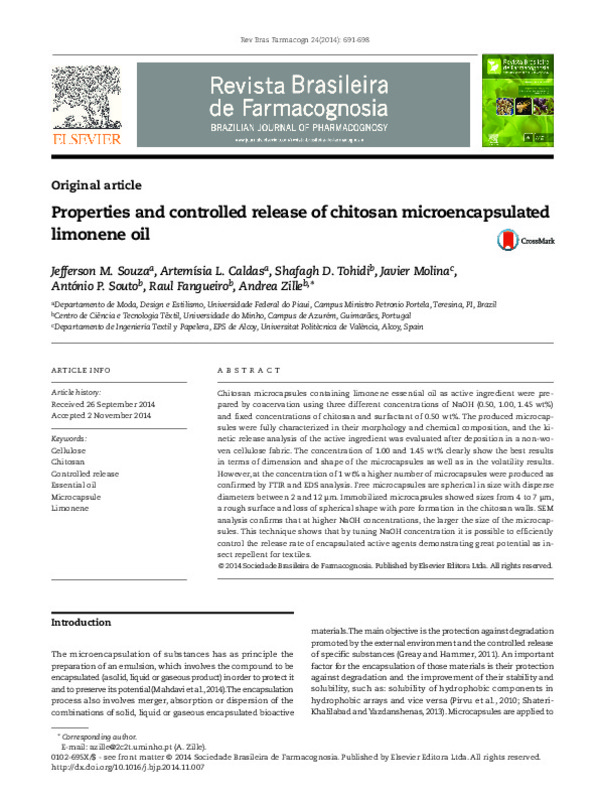Souza, JM.; Caldas, AL.; Tohidi, SD.; Molina Puerto, J.; Souto, A.; Fangueiro, R.; Zille, A. (2014). Properties and controlled release of chitosan microencapsulated limonene oil. Revista Brasileira de Farmacognosia. 24(6):691-698. https://doi.org/10.1016/j.bjp.2014.11.007
Por favor, use este identificador para citar o enlazar este ítem: http://hdl.handle.net/10251/85648
|
Título:
|
Properties and controlled release of chitosan microencapsulated limonene oil
|
|
Autor:
|
Souza, Jefferson M.
Caldas, Artemísia L.
Tohidi, Shafagh D.

 Molina Puerto, Javier
Souto, A.P.
Fangueiro, Raul
Zille, Andrea
Molina Puerto, Javier
Souto, A.P.
Fangueiro, Raul
Zille, Andrea
|
|
Entidad UPV:
|
Universitat Politècnica de València. Departamento de Ingeniería Textil y Papelera - Departament d'Enginyeria Tèxtil i Paperera
|
|
Fecha difusión:
|
|
|
Resumen:
|
[EN] Chitosan microcapsules containing limonene essential oil as active ingredient were prepared
by coacervation using three different concentrations of NaOH (0.50, 1.00, 1.45 wt%)
and fixed concentrations of chitosan ...[+]
[EN] Chitosan microcapsules containing limonene essential oil as active ingredient were prepared
by coacervation using three different concentrations of NaOH (0.50, 1.00, 1.45 wt%)
and fixed concentrations of chitosan and surfactant of 0.50 wt%. The produced microcapsules
were fully characterized in their morphology and chemical composition, and the kinetic
release analysis of the active ingredient was evaluated after deposition in a non-woven
cellulose fabric. The concentration of 1.00 and 1.45 wt% clearly show the best results
in terms of dimension and shape of the microcapsules as well as in the volatility results.
However, at the concentration of 1 wt% a higher number of microcapsules were produced as
confirmed by FTIR and EDS analysis. Free microcapsules are spherical in size with disperse
diameters between 2 and 12 μm. Immobilized microcapsules showed sizes from 4 to 7 μm,
a rough surface and loss of spherical shape with pore formation in the chitosan walls. SEM
analysis confirms that at higher NaOH concentrations, the larger the size of the microcapsules.
This technique shows that by tuning NaOH concentration it is possible to efficiently
control the release rate of encapsulated active agents demonstrating great potential as insect
repellent for textiles.
© 2014 Sociedade Brasileira de Farmacognosia. Published by Elsevier Editora Ltda. All rights reserved
[-]
|
|
Palabras clave:
|
Cellullose
,
Chitosan
,
Controlled release
,
Essential oil
,
Microcapsule
,
Limonene
|
|
Derechos de uso:
|
Reconocimiento - No comercial (by-nc)
|
|
Fuente:
|
Revista Brasileira de Farmacognosia. (issn:
0102-695X
)
|
|
DOI:
|
10.1016/j.bjp.2014.11.007
|
|
Versión del editor:
|
http://doi.org/10.1016/j.bjp.2014.11.007
|
|
Código del Proyecto:
|
info:eu-repo/grantAgreement/CAPES//8976%2F13-9/
info:eu-repo/grantAgreement/FCT//SFRH%2FBD%2F94759%2F2013/PT/
info:eu-repo/grantAgreement/CAPES//1071%2F13-0/
info:eu-repo/grantAgreement/Uminho//C2011-UMINHO-2C2T-01/
|
|
Agradecimientos:
|
JMS and ALC acknowledge CAPES Foundation, the Ministry
of Education of Brazil, Proc. nº 8976/13-9 e Proc. Nº 1071/13-
0, respectively, and the Department of Textile Engineering
of the University of Minho, Portugal. J. ...[+]
JMS and ALC acknowledge CAPES Foundation, the Ministry
of Education of Brazil, Proc. nº 8976/13-9 e Proc. Nº 1071/13-
0, respectively, and the Department of Textile Engineering
of the University of Minho, Portugal. J. Molina is grateful to
the Conselleria d’Educació, Formació i Ocupació (Generalitat
Valenciana) for the Programa VALi+D Postdoctoral Fellowship.
AZ (C2011- UMINHO-2C2T-01) acknowledges funding from
Programa Compromisso para a Ciência 2008, Portugal. Shafagh
Dinparast Tohidi would like to thank the Portuguese Foundation
of Science and Technology for providing the PhD grant SFRH/
BD/94759/2013.
[-]
|
|
Tipo:
|
Artículo
|









